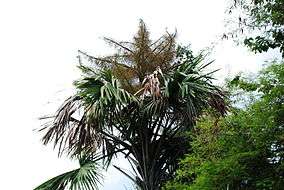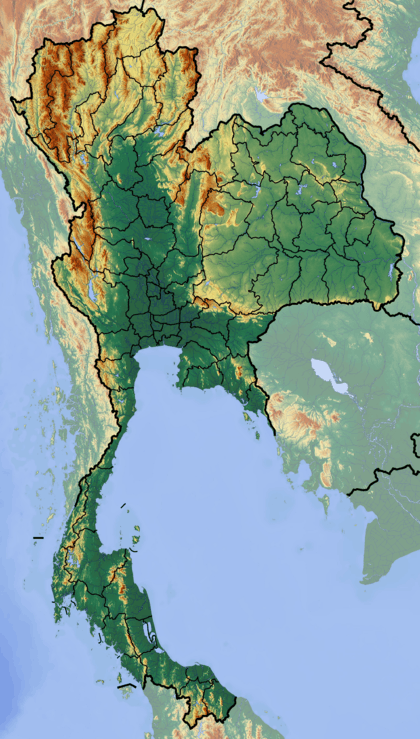Thap Lan National Park
| Thap Lan National Park | |
|---|---|
|
IUCN category II (national park) | |
 | |
 Location in Thailand | |
| Location | Prachinburi and Nakhon Ratchasima Provinces, Thailand |
| Nearest city | Kabin Buri |
| Coordinates | 14°12′N 101°55′E / 14.200°N 101.917°ECoordinates: 14°12′N 101°55′E / 14.200°N 101.917°E |
| Area | 2,236 km2 |
| Established | 1981 |
Thap Lan National Park (อุทยานแห่งชาติทับลาน) is in the Sankamphaeng Range in Prachinburi, Nakhon Ratchasima Provinces, Thailand. Established as a national park on 23 December 1981, it was the country's 40th national park.[1] Its attractions include Lan Forest and Recreational Garden (ป่าลานและสวนพักผ่อนหย่อนใจ); Namtok Thap Lan (or Namtok Heo Nok Kok) (น้ำตกทับลานหรือน้ำตกเหวนกกก); Thap Lan Reservoir (อ่างเก็บน้ำทับลาน); Namtok Huai Yai (น้ำตกห้วยใหญ่); Lam Mun Bon Dam (เขื่อนลำมูลบน); Hat Chom Tawan (หาดชมตะวัน).
Geography
With an area of 2,236 square kilometres (863 sq mi), it is Thailand's second largest national park. Thap Lan's headquarters is in Bu Phram, Na Di, Prachinburi Province.[1] Its areas include Tambon Bu Phram, Amphoe Na Di, Prachin Buri; Amphoe Pak Thong Chai, Wang Nam Khiao, Khon Buri, and Soeng Sang of Nakhon Ratchasima Province; and Amphoe Pakham of Buriram Province. The highest peak is 992 metres (3,255 ft) high Khao Lamang.[2] Terrain includes mountain ranges, valleys, chasms, and waterfalls.
Climate
Thap Lan has three main seasons, with a mean annual temperature of 28° C. The rainy season extends from May to October, when it rains most days. The wettest month is October. In the rainy season around 269 mm of rain falls at Thap Lan. The cold season is from November to February. The coolest month is December, with an average daily maximum of 24° C. The hot season is March and April, when temperatures can reach 31° C.[2]
Flora
Most of Thap Lan is covered in dry evergreen forest, particularly on lower mountain slopes. There are a number of important plant species found within this forest type, including Dipterocarps and Hopia. Bamboo is also often found in drier forests.
Near Ban Thap Lan, Ban Khun Sri Bupram, and Ban Wang Mued, are rare fan palm or Talipot palm forests. These forests covered much of the northeast region of Thailand in the past, though the spread of agriculture saw the destruction of a large number of palm forests. Today, Thap Lan is home to one of the few such forests remaining in Thailand. The fan palm is important in Thai culture as its leaves were used as the parchment on which Buddhist texts were inscribed.[2] Fan palms are an ancient plant that produce a single massive inflorescence, the largest in the plant kingdom, containing up to 60 million flowers. After this huge exertion of energy, the tree dies.
Fauna
As Thap Lan National Park covers such a large area, and is connected to Khao Yai, Pang Sida, and Ta Praya National Parks, it is home to a number of wild animals, including tigers, elephants, buffaloes, bangtang, serow, black bears, sun bears, crown gibbons, hornbills, pheasants, and lorikeets.[2] According to researchers, the park may have more tigers than China.[3]A total of 149 bird species have been confirmed within the park, including several rare species restricted to low-land evergreen forest, such as the green imperial pigeon, stork-billed kingfisher, and scaly-crowned babbler.[2]
There is hope that one of the world's most endangered mammals, the kouprey, may still survive in Thap Lan and Pang Sida National Parks. Though one has not been sighted within Thailand for more than 30 years, this primitive cattle species could provide genes valuable in the production of disease-free strains of domestic cattle.[2]
Conservation
Queen Sirikit's Dong Phayayen-Khao Yai Forest Complex includes Thap Lan and five other related areas: Khao Yai National Park, Pang Sida National Park, Ta Phraya National Park, Phra Phuttha Chai National Park, and Dongyai Wildlife Sanctuary.[2]While elephant hunting is common in the Dangrek Range, elephants are better protected in Thap Lan.[4]:21
References
- 1 2 "Thap Lan National Park" (Travel). Bangkok Post. Bangkok Post. Retrieved 7 May 2016.
- 1 2 3 4 5 6 7 "Thap Lan National Park". Department of National Parks (DNP). Retrieved 7 May 2016.
- ↑ Watts, Jonathan (16 May 2011). "Thailand jungles mask surprise rise in tiger numbers". The Guardian. Retrieved 1 October 2011.
- ↑ Sukumar, R (30 April 1993). The Asian Elephant: Ecology and Management. Cambridge University Press. ISBN 978-0-521-43758-5. Retrieved 1 October 2011.
External links
| Wikimedia Commons has media related to Thap Lan National Park. |